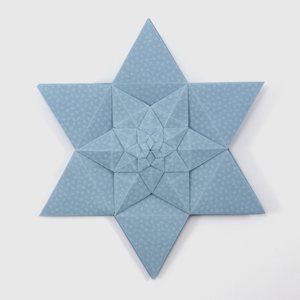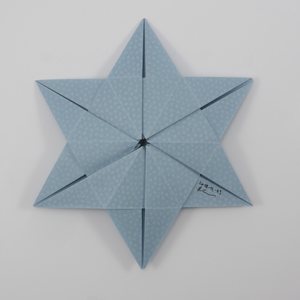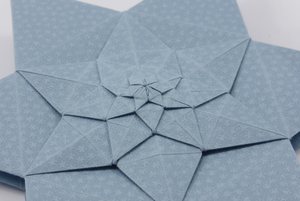Lucky Star Fractal



This is a recursive version of the Lucky Star molecule. Just like the non-recursive version, it can be tessellated or used for decorating a box. The back of this model when folded standalone rather than tessellated can either be closed or it can be opened and some extra flaps folded up which results in a pattern resembling a flower.
Despite this not being the first time around this model is invented (see below), I’m really happy with it. The collapse is rather difficult at first, but with some practice it becomes quite pleasant, especially if you only fold up to level 3 (the one in the picture is level 5, folded from a 35 cm sheet of Edokosome paper). The scaling factor is √3 which means that the levels shrink quite rapidly, and a large sheet is needed to go many levels deep. After 4 iterations, this molecule is reduced by a factor of 9, compared to just a factor of 4 for the Hydrangea whose scaling factor is √2. Also, due to this model’s construction, folding levels deeper than 3 requires reaching through multiple already collapsed layers which is difficult and nigh-impossible without the help of a folding tool. However, a level 3 Lucky Star Fractal can be folded from a hexagon cut from an A4 sheet and it is quite quick to fold, compared to many of my other models. I rarely fold a model more than once, but the level 3 version of this star I have folded many times over since it makes a nice decoration and after some learning, is a real pleasure to fold.
While I came up with this design myself, due to some research I performed after designing the regular Lucky Star, I learned that others have designed the same model before me. Haligami (Halina Rościszewska-Narloch) played with a recursive version of her Day and Night Tessellation, which is almost exactly the same model as this one (only the locking of the rays in the last level is different). Shuzo Fujimoto designed this model even earlier — I was able to identify it thanks to some pictures posted by Eric Gjerde who reproduced the model based on a CP found in a book. We don’t know what name Fujimoto used — Gjerde used the name Logarithmic Star. A few other people (e.g. Andrew Hudson — see this comment and Aneta Origami – this comment) have also come up with this idea independently.
There are also a number of models which differ from this one, but still exhibit a number of similarities, either in the look of the finished model or in the way it is constructed. Melisande designed Star Unlimited a la Fujimoto which looks the same on the front side but has a different back and a different CP. The general construction is similar to Blooming Fractal Flower by Joanna Sobczyk. In the open-back variant, the back side resembles Floral Perpetua by Dasa Severova. There is also Double and Triple Fractal Star by Monika Hanková and their variant by Endre Somos.
Given how elegant this model is, I am surprised that it has not reached the popularity of Fujimoto’s Hydrangea. I have taught this model at several conventions, and I try to promote it where possible so that it becomes as well known as I think it deserves.
Comments